Genus Cyclura Rank Subspecies | Phylum Chordata | |
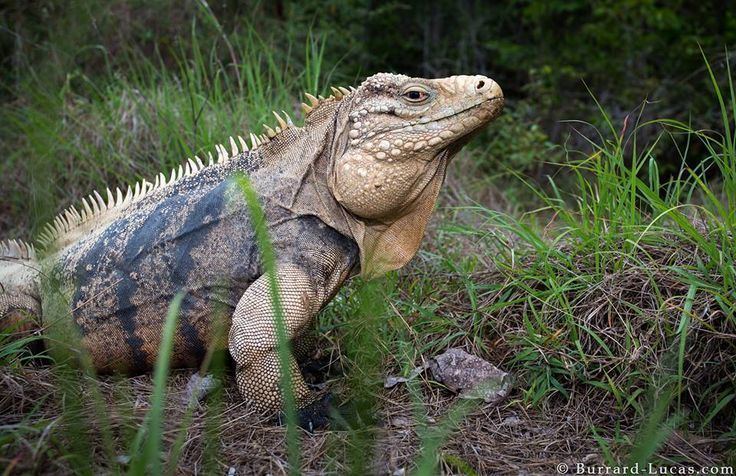 | ||
Scientific name Cyclura nubila caymanensis Similar Cyclura, Cyclura nubila, Northern Bahamian rock igua, Reptile, Cyclura pinguis | ||
The Lesser Caymans iguana (Cyclura nubila caymanensis), also known as the Cayman Brac iguana, Cayman Island brown iguana or Sister Isles iguana, is a critically endangered subspecies of the Cuban iguana (Cyclura nubila). It is native to two islands to the south of Cuba: Cayman Brac and Little Cayman, which are also known as the Sister Isles due to their similar shapes and close proximity to each other. This subspecies is in decline due to habitat encroachment by human development and predation by feral dogs and cats. It is nearly extinct on Cayman Brac (less than 100 animals), and Little Cayman supports a population of about 1,500 animals.
Contents
- Taxonomy
- Anatomy and morphology
- Distribution and habitat
- Diet
- Mating
- Endangered status
- Causes of decline
- Recovery efforts
- Captivity
- References
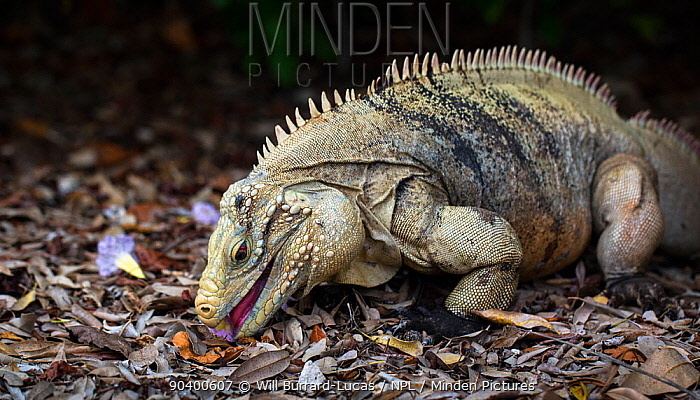
Taxonomy
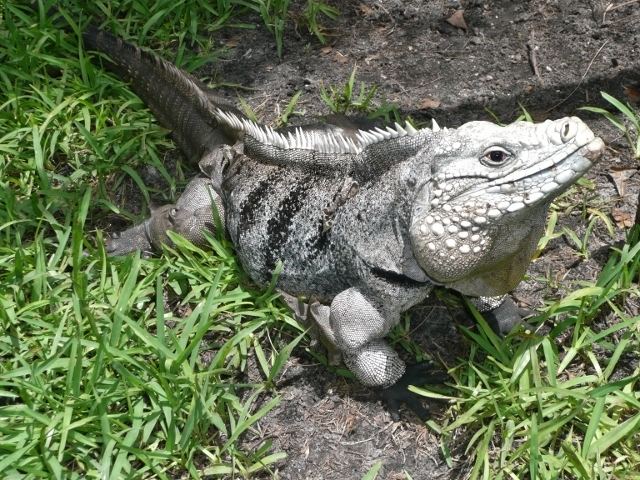
The Lesser Caymans iguana, Cyclura nubila caymanensis, is endemic to the islands of Little Cayman and Cayman Brac. It is a subspecies of Cuban iguana. This subspecies has been introduced to Grand Cayman, where it has interbred with that island's endemic blue iguana (Cyclura lewisi).
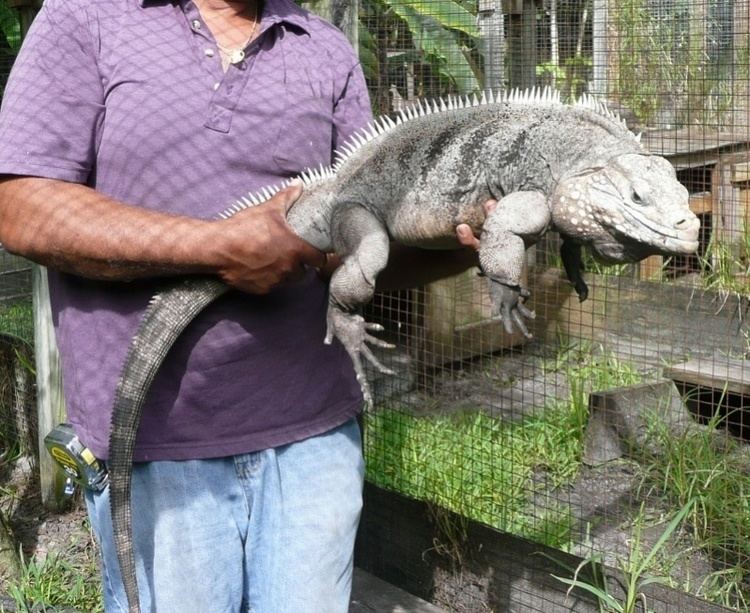
The generic name (Cyclura) is derived from the Ancient Greek cyclos (κύκλος) meaning "circular" and ourá (οὐρά) meaning "tail", after the thick-ringed tail characteristic of all Cyclura. Its specific name, nubila, is Latin for "gray" but in this instance is a Latinized form of the name of John Edward Gray, the British zoologist who first described the Cuban rock iguana as a species in 1831 as opposed to the animal's base color. Its subspecific name Caymanensis refers to the island where it lives being a Latinized form of "Cayman".
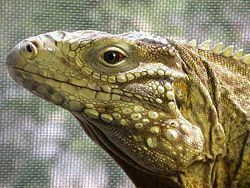
Zoologists Thomas Barbour and Gladwyn Kingsley Noble first described the Lesser Caymans iguana as a species in 1916. Chapman Grant, in a monograph published in 1940, formally described the Lesser Caymans iguana for the first time as a subspecies: Cyclura macleayi caymanensis.
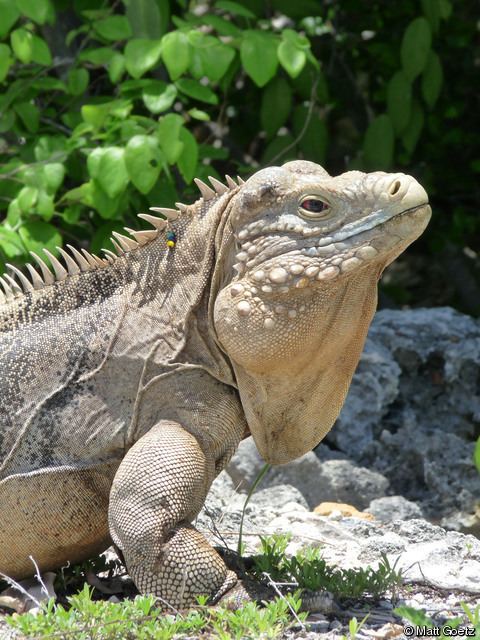
In 1975 Albert Schwartz and Thomas established the trinomial nomenclature, Cyclura nubila caymanensis for the Lesser Cayman iguana. They maintained that this lizard was a subspecies of Cyclura nubila, commonly known as the Cuban rock iguana (the population from which it evolved and can breed with if placed together under artificial conditions).
Anatomy and morphology
The Lesser Caymans iguana, Cyclura nubila caymanensis, is a medium to large animal with an average total length between 30 and 40 inches. Males are significantly larger than females. The Lesser Caymans iguana has a skin color from light grey to green when mature, with a light blue or reddish-pink colored head, whereas females are more olive green, lacking any red or blue. Young animals tend to be uniformly dark brown or green with faint dark bands. Their distinctive black feet stand in contrast to the rest of their lighter overall body color. Their eye-color is typically brown to blood red. An individual of this subspecies has been recorded as one of the longest lived of all species and subspecies of the genus Cyclura at 33 years.
This species, like other species of Cyclura, is sexually dimorphic; males are larger than females, and have more prominent dorsal crests as well as larger femoral pores on their thighs, which are used to release pheromones.
Distribution and habitat
Native to the islands of Little Cayman and Cayman Brac, this subspecies has been introduced to Grand Cayman.
Like other members of the Genus Cyclura the Lesser Caymans iguana requires suitable areas in which to bask, forage, nest, and hide. On Little Cayman these requirements are met in a variety of interior habitats even though the iguanas are widely dispersed.
An ongoing population survey on Cayman Brac in 2012 has counted and pit-tagged 86 individuals. One of these was killed by a vehicle in April 2012. There are additional individuals which have been spotted but not yet captured and pit-tagged.
Diet
Like all Cyclura species the Lesser Caymans iguana is primarily herbivorous, consuming leaves, flowers and fruits from over 100 different plant species. This diet is very rarely, if ever supplemented with animal matter.
Mating
Mating occurs in April to May depending when the dry season ends, and 7-25 eggs are usually laid in May or June depending on the size and age of the female. Due to being forced to dwell inland where the soil is rocky, the females often have to migrate to coastal areas in order to build their nests in the sand. The hatchlings emerge from the nests in August to early September.
Endangered status
The Lesser Caymans iguana is critically endangered according to the current IUCN Red List endangered species. The subspecies is vital to its native ecosystem as a seed disperser for native vegetation, and its extinction could have serious consequences as many of Little Cayman's and Cayman Brac's plants are not found elsewhere.
Causes of decline
Habitat destruction is the main factor threatening the future of this iguana. The iguanas nest in the sand of beaches that are a prime real-estate location on Little Cayman.
Predation and injury to hatchlings by rats, to hatchlings and sub-adults by semi-domestic and feral cats, and killing of adults by roaming dogs are all placing severe pressure on the remaining wild population on both islands.
Sister Island iguanas are all too frequently killed by vehicles.
Recovery efforts
A formal captive breeding program does not exist for this subspecies but it may be warranted for the Cayman Brac population. As the population on Cayman Brac has not been found to be genetically distinct from the Little Cayman population; genetic diversity may be introduced from the Little Cayman population if it is needed.
Captivity
The Lesser Caymans iguana is established in captivity, both in public and private collections. Private individuals have established these animals in captive breeding programs (both purebred and occasionally mixed with either the blue iguana, Cuban iguana, and sometimes with both) minimizing the demand for wild-caught specimens for the pet trade.
